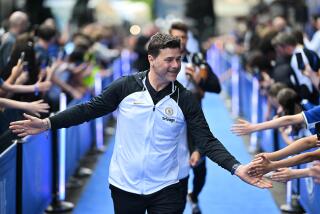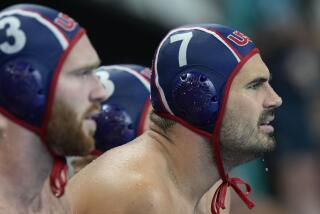Triple Threat
- Share via
SALT LAKE CITY — If the United States has one advantage in the ultra-competitive men’s Olympic hockey tournament, it’s supposed to be home ice.
That’s a misnomer. Home crowd? Yes. A couple of players already have heard from the U.S. women’s team about how loud and supportive the fans have been.
“I think we’re going to see a lot of patriotism out there when we step on the ice Friday night,” goaltender Mike Dunham said. “It’s going to be a great hockey atmosphere.”
But the ice is foreign. The International Ice Hockey Federation--which governs plays outside of the NHL--uses a rink that is 15 feet wider than the North American standard
“It’s a built-in advantage for the Europeans,” U.S. Coach Herb Brooks said.
“There’s so much more room for a forward to create offense that we’re going to have to be on top of our defensive game,” said forward Bill Guerin, who plays for the Boston Bruins. “In the NHL, the ice is a lot smaller and you can go out of your way to make a big hit without getting burned. If we do that too many times, there’s just too much open space. If we run around and try to make big hits all the time, there’s more area for us to get burned.”
The Europeans who play in the NHL will have to make the adjustment as well. But they’ll be joining teammates who are accustomed to the larger surface.
If there’s a pattern midway through the second Olympics to use NHL players, it might be the fewer pros, the better. The Czech Republic won the gold medal in 1998 with fewer NHL players than any other team in Nagano. The two teams to advance out of preliminary-round play in Salt Lake, Germany and Belarus, have only three NHL players between them.
The so-called Super Six teams that join the action today--the United States, Canada, Finland, Czech Republic, Russia and Sweden--will try to create an instant chemistry after only one day of practice. The talent is so evenly distributed that, “Anyone can win this baby,” Brooks said.
“I think it’s going to come down to who’s playing better as a team,” said Dunham, of the Nashville Predators. “Every team can skate, every team has skill.”
The United States begins its gold medal quest today against a Finland team led by San Jose Shark Teemu Selanne, Dallas Star Jere Lehtinen and Carolina Hurricane Sami Kapanen.
Brooks said he is considering line combinations of St. Louis Blue Doug Weight, Philadelphia Flyer John LeClair and Detroit Red Wing Brett Hull, another of Guerin, Dallas Star Mike Modano and Chicago Blackhawk Tony Amonte. He also is thinking about reuniting St. Louis’ Keith Tkachuk and Philadelphia’s Jeremy Roenick, who were teammates with the Phoenix Coyotes.
Chances are these NHL players will happily do whatever Brooks says. They were all at that young, impressionable age when Brooks coached the 1980 team to the gold medal in Lake Placid, N.Y.
“Who would have thought when I was 7 years old that I would be playing for Herb Brooks?” Dunham said.
Dunham recalled visiting Lake Placid for a youth hockey league game that summer and peering through the windows of the darkened arena at the site of the “Miracle on Ice.”
Others reenacted Mike Eruzione’s winning goal against the Russians in their basements. It was a pivotal moment in U.S. hockey
“It was a huge inspiration for me at that time and still is,” Guerin said. “It’s one of the big reasons I love the game and why I really decided to pursue a career in the game.”
You could say this team is a direct descendant of the 1980 squad--and one of the last. Future teams will feature players who were too young to vividly remember the 1980 gold medal, or hadn’t even been born yet.
The group of pros is trying to erase the memory of the Nagano Games--a disappointing 1-3 record that failed to land a medal, followed by vandalism and broken furniture in the team’s dorm.
“Nagano was four years ago,” Guerin said. “We can put that behind us. We can put that to bed.”
More to Read
Go beyond the scoreboard
Get the latest on L.A.'s teams in the daily Sports Report newsletter.
You may occasionally receive promotional content from the Los Angeles Times.






